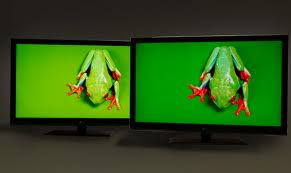Color purity and range have plateaued; new technology from Nanosys promises improvements.
By Jon Peddie
When LCD displays took over in the computer and TV industry they brought us thinness, less power consumption, and artificially lower prices, with restricted refresh rates, viewing angle, and color spectrum. Various companies like Dolby, HP, Portrait Displays, and TruSight have built clever technologies to overcome the limitations of the basic twisted nematic (TN) crystals. The biggest breakthroughs have been the substitution of the cold cathode fluorescent lamp (CCFL) backlighting with LEDs. Quite a bit of effort has been put into backlighting LCD panels but LEDs seem to be the best choice for now.

However, the LEDs introduce yet another problem; they shift the gamut and color purity of the displays. “Purity” is a problematic term because there are several color spaces to be taken into consideration:
- sRGB, found in basic Windows and most other computer systems
- Adobe RGB, a wider richer color space preferred by photographers and many cinema artists
- NTSC used by TV stations
and others, to name just a few. Adobe however, is the current favorite and the one most monitor suppliers who have something to say about color tend to compare themselves to, making statements such as “80% of Adobe RGB.” That’s a ridiculous statement because it doesn’t tell you if it is a balanced 80% or it is 100% red 100% blue and 40% green.
And then there’s the color range of the primaries, expressed in bits. Most displays are limited to 8-bits per primary which has to do with how far and accurately you can get the TN crystal to twist (which act as a valve to regulate how much of the backlight comes through.) HP, NEC, and others have extended the primary range to 10-bits with various techniques like dithering, FRC, and an honest 10-bit signal. But adding zillions of more colors doesn’t help if they are wrong to begin with.
One of the more clever techniques we’ve seen is Nanosys’ approach to put an excitable tuned optical filter between the backlight and the TN panel. Using what they call quantum dot technology the company claims it can enable LCDs to display about 50% more color than they can today. The result is greener greens, bluer blues.
Quantum dot phosphors are larger than a water molecule, but smaller than a virus. Embedded in a sheet of plastic these tiny phosphors convert blue light from a standard GaN LED into different wavelengths based upon their size. Larger dots emit longer wavelengths (red), while smaller dots emit shorter wavelengths (green). Blending together a mix of dot colors allows Nanosys to engineer a new spectrum of light. This enables LCD manufacturers to accurately match their LED backlight to their LCD color filters to achieve the best possible color and efficiency. The result is professional photo and cinema level color performance found in high-end monitors from Dolby, HP, and NEC.
The QDEF effect
Quantum Dot Enhancement Film (QDEF) is an optical film component for LCD displays with LED-driven backlighting that can be scaled to any size, from tablets to large format televisions. The sheet is designed to replace the functionality of a diffuser sheet while actively converting color. QDEF can simply be added to the stack with little change in overall thickness or manufacturing process.
Nanosys says its QDEF integrates easily and affordably on a mass scale with existing LCD BLU manufacturing processes. The company has formed commercial agreements with electronics component manufacturers including LG Innotek (LGIT) and Samsung for the first commercial application of quantum dots in consumer electronics. With the need for brighter, cheaper, better LED displays in everything from HD televisions to tablet PCs, Nanosys thinks its materials will unlock the barriers to an enhanced color experience.
Samsung the television and display maker was impressed enough to invest in Nanosys last year. It and LG, another big display maker, are Nanosys partners. With their backing and the interest of other major TV makers, Nanosys expects the first devices containing its technology—probably tablets or notebook computers, to be in stores in the first half of next year. Televisions with the Nanosys technology should hit the market by the end of next year.

Coming to desktops soon
The company was formed in 2001 and acquired the rights to patents from MIT on quantum dot and other materials science. Jason Hartlove, Nanosys’ CEO told us the panels can actually improve power efficiency by tuning to the sweet spot of the backlight. The company also has interesting applications in battery technology. When combined with color management from the controller via software like Portrait Display’s Chroma Tune, a near perfect wide-color gamut display can be produced at reasonable costs that will reach the consumer market. Next year we should see the first results of these developments.





